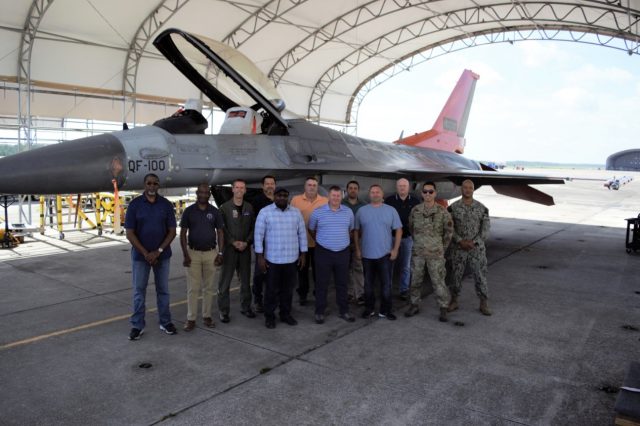
The US Air Force has taken delivery of the final QF-16 “Zombie Viper” aerial target from Boeing as the aircraft was handed over to the 82nd Aerial Targets Squadron at Tyndall Air Force Base in Panama City, Florida.
The last of over 75 drone targets from the QF-16 modification line at Cecil Airport was accepted by Defense Contract Management Agency Aircraft Integrated Maintenance Operations St. Augustine personnel on July 29.
A second QF-16 line, based at the 309th Aerospace Maintenance and Regeneration Group in Tucson, will continue to operate through the remaining procurement contract. More than 120 of the retired F-16 are to be modified into aerial targets under the current contract.
QF-16 is an optionally piloted, reusable aerial target system modified from previously-retired legacy F-16 aircraft, which were once used in Air Force combat missions.
After modification, the aircraft can be flown by a pilot or via remote control by a skilled group of ground operators and technicians who monitor performance.
Without risk to aircrew, the aircraft can fly a multitude of missions, to include the testing of newly developed weapons systems, air-to-air live fire training, ground-to-air live fire missile tests, auto takeoff and landing, and supersonic flight.
The QF-16 Zombie Viper’s first unmanned flight took place Sept. 23, 2013. Since then, more than 75 modified aircraft have been delivered from the Boeing facility in Jacksonville.
The QF-16 platform is the successor to the QF-4 Phantom drone, which was retired in 2016.
Boeing previously received retired F-16 aircraft, which were regenerated from storage at the 309th Aerospace Maintenance and Regeneration Group in Tucson, Arizona, and flown to Cecil Airport for installation of drone equipment to prepare the aircraft for its newfound mission.
DCMA and its industry counterparts faced various obstacles throughout the production lifespan of the QF-16 aircraft. Those obstacles included supply chain disruptions, the COVID-19 pandemic and a variety of maintenance issues on the 30-plus year-old aircraft.
“We worked daily, directly on the hangar floor, and hand-in-hand with the contractor, to resolve a variety of production issues,” said Michael Jackson, a quality assurance specialist with DCMA AIMO St. Augustine. “Our DCMA team worked diligently to overcome all obstacles, alleviating production delays, and delivering the remaining aircraft on schedule and under budget.”
“The QF-16 provides a crucial capability to both the Air Force and Navy in the development of next generation weapon systems,” said Navy Cmdr. Gabriel Hohner, DCMA AIMO St. Augustine commanding officer. I am proud of the partnership DCMA has had with Boeing here to deliver this capability.”
The QF-16’s have always been delivered from Boeing to the 82nd Aerial Targets Squadron at Tyndall Air Force Base for operational use. Each aircraft maintains a lifespan of approximately 300 flight hours.


























